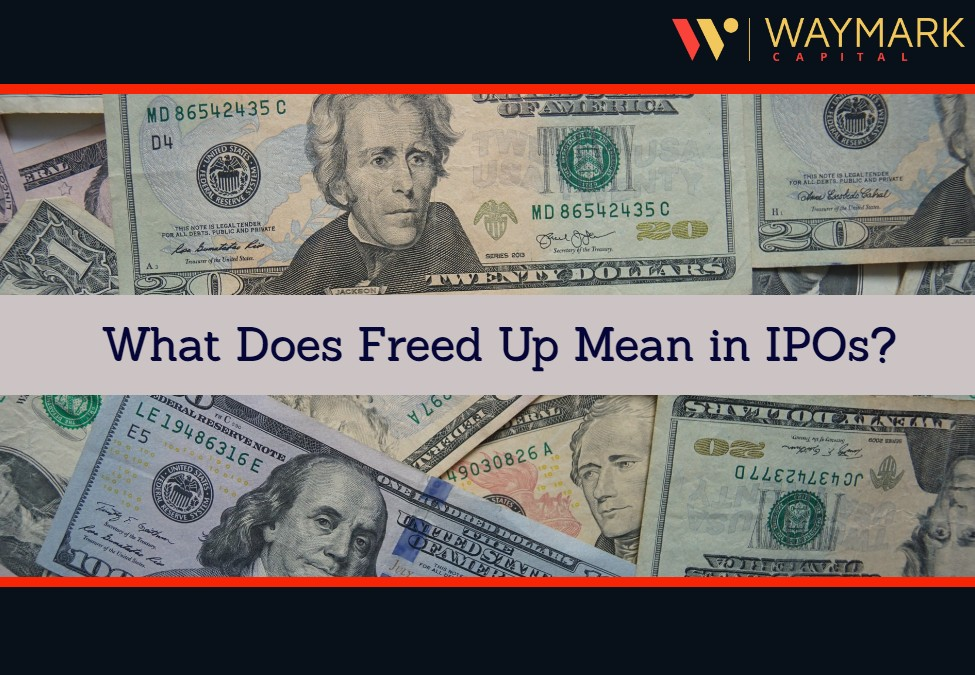
21 July 2022
The term “freed up” is very common in IPO land. What does it mean and how does it affect investors and other IPO stakeholders?
Freed up can be defined in two ways depending on the party involved and the stage of an IPO. Freed up can refer to when an IPO underwriter in a fixed price offering is allowed to sell left-over IPO shares at prevailing market prices.
The more common use for the term however is the point when insiders are allowed to sell their shares after a “lock-up period”. In this sense, “freed up is the antonym of “locked up”. A majority of IPOs usually have a “locked up” period even though it is not required by the SEC.
Investment bank underwriters usually make time-limited commitments concerning the IPO subscription volumes and pricing until the IPO becomes freed up. The freed period in the context of underwriter commitments happens immediately after the bidding phase.
Here is an example of how an IPO underwriter uses the freed-up period to offload leftover shares:
Company A is planning to go public and selects investment bank X to manage the IPO. The main of an IPO is to raise more capital by selling company equity in the form of shares to external investors. As such, underwriter X is required to ensure the IPO shares are correctly priced which will boost subscription rates early on.
Underwriter X ensures the IPO is well-structured to be approved by the SEC and uses its financial expertise to determine an ideal offer price and the number of shares to be sold. They invite bids from a pool of accredited institutional investors who in turn submit their requests on how many IPO shares they wish to buy in a process called IPO subscription.
The IPO bidding phase which primarily involves share trading between accredited institutional investors and the underwriter is also a “lock-up” period for the underwriter. During this period, the underwriter is not able to sell the IPO shares at a price other than the offer price. Underwriter X can engage in market stabilization and IPO marketing at this point to boost uptake.
The locked period for underwriter X ends when the IPO is finally listed in the markets with a listing price- usually 25 days from the day the offer price was determined. It is at this point that the freed-up period kicks in and the underwriter is free to offload any left-over shares at market rates.
Note: It is important to note that the role of underwriters in an IPO is to ensure there is satisfactory uptake of the IPO in the bidding phase (usually 100% or more). IPO underwriters are expected to have a healthy pool of institutional investors to who they can advertise the IPO. These include pension funds, high net-worth individuals, hedge funds, mutual funds, etc. It is therefore rare to find an underwriter having left-over IPO shares to sell at market rates after listing.
A more common occurrence of a freed-up period has to do with investor behavior. Most initial public offerings include a lock-up agreement between the IPO underwriter and the issuing company. A lockup agreement restricts company insiders and early investors from selling their shares for some time.
Lockup periods are important for IPOs because they prevent unfavorable price volatility in the initial period. IPO lock-up periods usually last 90 to 180 days depending on the agreement.
The Freed-up period for an IPO starts when the lock-up period lapses. It allows insiders and early investors to sell their shares in the markets at prevailing prices. Typically, external investors always want to anticipate what will happen as soon as the freed-up period kicks in to capitalize. They do this by analyzing the IPOs performance since listing and other metrics.
There is a lot of meaning attached to the behavior of insiders and early investors as soon as the IPO becomes freed up. If a significant percentage of them decide to dump their shares, it may indicate a lack of confidence in the corporation’s financial prospects at that time. Insider selling appetite in the early days after the lock-up period usually affects the share price negatively.
Ideally, IPO insiders are expected to hold on to their shares because they have confidence in the company and stand to gain in the long run. However, because of “money motivations,” some insiders may decide to sell since the offer price is usually lower than the market price. The money they get selling these shares is what is referred to as “freed up cash” in an IPO.
In the context of an IPO, freed-up cash is calculated using the prevailing market price of the IPO shares and the number of shares up for sale. To calculate the amount of freed-up cash available, one multiplies the number of shares by the current share price minus brokerage fees and transaction charges. Start your journey to your IPO today!